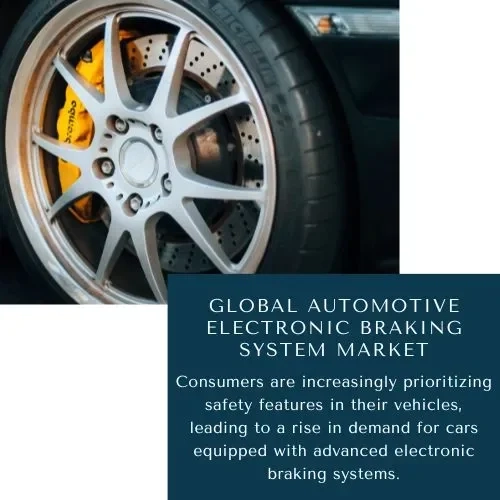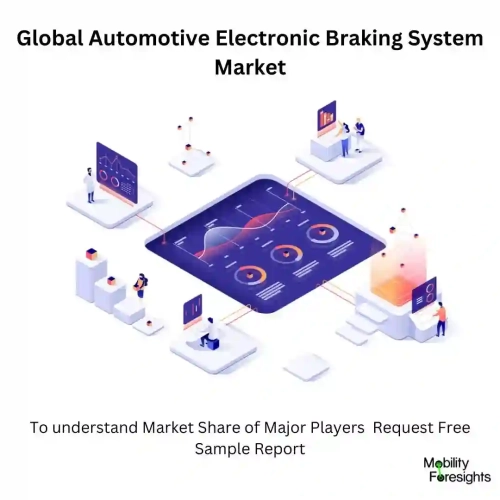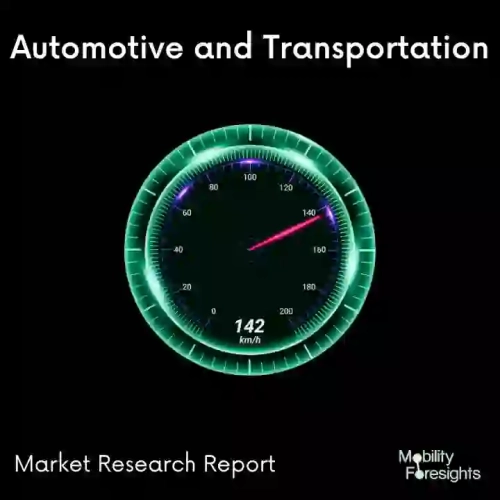AUTOMOTIVE ELECTRONIC BRAKING SYSTEM MARKET
KEY FINDINGS
- Global regulations like UNECE R13/R78 and NHTSA FMVSS 135 are mandating the adoption of advanced braking systems like Anti-lock Braking Systems (ABS) and Electronic Stability Control (ESC), propelling market growth.
- The integration of features like Automatic Emergency Braking (AEB) and Lane Departure Warning (LDW) necessitates sophisticated electronic braking systems, driving market demand.
- Self-driving cars rely heavily on precise and reliable electronic braking systems for safe operation, creating a significant growth opportunity.
- Consumers are increasingly prioritizing safety features in their vehicles, leading to a rise in demand for cars equipped with advanced electronic braking systems.
- The market is transitioning from basic ABS and ESC systems towards more complex Electronic Brake-force Distribution (EBD) and Autonomous Emergency Braking (AEB) systems, offering enhanced functionality and safety.
- Electronic braking systems are becoming increasingly integrated with other ADAS features, creating a more comprehensive safety suite for modern vehicles.
- Traditional mechanical braking systems are gradually giving way to brake-by-wire technology, offering faster response times and improved controllability.
- Radar, LiDAR, and camera sensors are being incorporated into electronic braking systems to gather real-time data on vehicle surroundings and enable features like AEB.
- Sophisticated software algorithms are crucial for interpreting sensor data and actuating braking interventions with precision and speed.
- As electronic braking systems become more complex, robust cybersecurity measures are essential to mitigate hacking risks.
- Advanced electronic braking systems can be expensive to develop and integrate into vehicles, potentially hindering adoption in budget-conscious markets.
- Asia Pacific is the fastest-growing region due to rapid automotive production growth, particularly in China and India. Government regulations mandating safety features are also driving market expansion.
- Europe is a technologically advanced region with stringent safety regulations and a strong focus on ADAS development, creating a demand for sophisticated electronic braking systems.
- North America is a mature market with established players and a growing adoption of ADAS features. However, North America may face competition from Asia Pacific in terms of overall market size.
AUTOMOTIVE ELECTRONIC BRAKING SYSTEM MARKET OVERVIEW
The global automotive electronic braking system market is accelerating rapidly, fueled by a confluence of factors. Stringent safety regulations are mandating features like ABS and ESC, while the rise of Advanced Driver-Assistance Systems (ADAS) like AEB and LDW necessitates more sophisticated electronic braking.
The development of autonomous vehicles further intensifies demand for precise and reliable braking systems. Consumers are also increasingly prioritizing safety features, driving market growth. However, challenges remain. The high cost of developing and integrating these systems can be a hurdle, and creating consumer awareness about their benefits is crucial. Additionally, infrastructure limitations may slow the full potential of some advanced features.

Despite these constraints, the future looks bright, particularly in regions like Asia Pacific with booming automotive production. The market is also witnessing a shift towards more complex systems with advanced sensor technologies and sophisticated software, highlighting the growing importance of both hardware and software expertise in this critical automotive safety sector.
INTRODUCTION TO AUTOMOTIVE ELECTRONIC BRAKING SYSTEM MARKET
The automotive industry is undergoing a transformative shift towards advanced safety and braking technologies, with electronic braking systems (EBS) emerging as a cornerstone of vehicle safety. An electronic braking system, commonly referred to as "brake-by-wire," replaces traditional hydraulic braking systems with electronically controlled actuators to modulate braking force. This paradigm shift heralds a new era of precision, responsiveness, and safety in vehicle braking.
At the heart of the automotive electronic braking system is a sophisticated network of sensors, controllers, and actuators that work in tandem to optimize braking performance in diverse driving conditions. By electronically coordinating the braking force applied to each wheel independently, EBS enhances vehicle stability, traction, and maneuverability, especially during emergency braking and low-traction scenarios.
Moreover, automotive electronic braking systems pave the way for advanced driver assistance features such as autonomous emergency braking, collision avoidance, and regenerative braking. These systems leverage real-time data from sensors, including wheel speed, yaw rate, and brake pressure sensors, to anticipate and mitigate potential hazards on the road, thereby enhancing overall vehicle safety.
In addition to safety benefits, electronic braking systems offer significant advantages in terms of energy efficiency, vehicle dynamics, and maintenance. By optimizing brake actuation and distribution, EBS minimizes energy wastage and maximizes the effectiveness of regenerative braking systems in hybrid and electric vehicles. Furthermore, the integration of electronic stability control (ESC) and traction control systems (TCS) enhances vehicle stability and traction control, especially on slippery or uneven road surfaces.
As automakers and consumers alike prioritize safety, comfort, and sustainability, the adoption of automotive electronic braking systems is poised to accelerate. With ongoing advancements in sensor technology, vehicle connectivity, and artificial intelligence, EBS is expected to evolve further, ushering in a future where vehicles can anticipate and prevent accidents proactively.
In summary, automotive electronic braking systems represent a paradigm shift in vehicle safety and performance, setting new benchmarks for innovation and excellence in the automotive industry.
AUTOMOTIVE ELECTRONIC BRAKING SYSTEM MARKET SIZE AND FORECAST

The Global Automotive Electronic Braking System Market accounted for $XX Billion in 2023 and is anticipated to reach $XX Billion by 2030, registering a CAGR of XX% from 2024 to 2030.
AUTOMOTIVE ELECTRONIC BRAKING SYSTEM MARKET TECHNOLOGICAL TRENDS
Sensor Fusion for a Clearer Picture:
- Advanced Sensor Integration: Modern electronic braking systems are no longer limited to just wheel-speed sensors. Radar, LiDAR, and camera sensors are being incorporated to gather real-time data on the surrounding environment.
- Sensor Fusion Algorithms: Sophisticated software algorithms play a crucial role in fusing data from various sensors to create a comprehensive picture of the vehicle's surroundings. This allows for more precise and timely braking interventions.
Software Takes the Wheel: The Brains Behind the Braking
- Advanced Control Algorithms: The ability to interpret sensor data and translate it into precise braking actions relies heavily on cutting-edge software algorithms. These algorithms are constantly evolving to improve response times and braking controllability.
- Machine Learning for Adaptive Braking: Machine learning algorithms are being explored to enable electronic braking systems to learn from driving patterns and adapt braking behavior to different road conditions and driver styles.
The Rise of By-Wire Technology: A More Responsive Braking System
- Replacing Mechanics with Electronics: Traditional mechanical linkages between the brake pedal and wheels are gradually being replaced by electronic signals in brake-by-wire systems. This offers:
- Faster Response Times: Electronic signals travel much faster than mechanical linkages, enabling quicker braking intervention.
- Improved Controllability: By-wire systems allow for more precise control over braking force distribution between wheels, enhancing vehicle stability.
Cybersecurity: Safeguarding the Brakes of the Future
- Securing the Software Defined Brakes: As electronic braking systems become more complex and reliant on software, robust cybersecurity measures are essential. This includes encryption, secure coding practices, and vulnerability assessments to mitigate the risk of hacking and ensure system integrity.
V2X Communication: Braking in Harmony with the Connected World
- Vehicle-to-Everything (V2X) Communication: Emerging V2X technology allows vehicles to communicate with each other and roadside infrastructure. This enables features like cooperative emergency braking, where vehicles can share information on sudden stops, allowing for coordinated braking maneuvers and preventing collisions.
AUTOMOTIVE ELECTRONIC BRAKING SYSTEM MARKET NEW PRODUCT DEVELOPMENT
Bosch has introduced the iBooster, an innovative electromechanical brake booster system that enhances the performance of electronic braking systems. The iBooster offers improved brake response, energy recuperation capabilities, and compatibility with advanced driver assistance systems (ADAS) for enhanced vehicle safety.
Continental has developed the MK C1 electronic braking system, which integrates traditional brake components with electronic control units (ECUs) to provide advanced braking functionality. The MK C1 offers features such as brake-by-wire technology, regenerative braking, and predictive emergency braking assistance for enhanced vehicle safety and performance.
ZF has introduced the Gen5 EPB (Electronic Parking Brake) system, which combines electronic actuation with hydraulic brake components to provide precise and reliable braking performance. The Gen5 EPB offers features such as automatic hill-hold assist, drag torque control, and intelligent brake blending for improved vehicle dynamics and efficiency.
Aisin has developed the Electronically Controlled Brake (ECB) system, which integrates brake actuation, modulation, and control functions into a single compact unit. The ECB system offers features such as brake force distribution, anti-lock braking, and brake assist for enhanced vehicle safety and stability in various driving conditions.
Advics has introduced the i-ACT (Intelligent Active Control Technology) electronic braking system, which utilizes advanced algorithms and sensor fusion techniques to optimize brake performance in real-time. The i-ACT system offers features such as predictive braking, cornering brake control, and adaptive regenerative braking for improved vehicle handling and energy efficiency.
Brembo has developed the B-Elect electronic braking system, which combines high-performance brake components with electronic control units for superior braking performance and reliability. The B-Elect system offers features such as brake-by-wire technology, dynamic brake force distribution, and customizable braking profiles for enhanced driving experience and safety.
AUTOMOTIVE ELECTRONIC BRAKING SYSTEM MARKET SEGMENTATION
By System Type
- Anti-lock Braking Systems (ABS)
- Electronic Brake-force Distribution (EBD)
- Electronic Stability Control (ESC)
- Traction Control Systems (TCS)
- Advanced Emergency Braking Systems (AEB)
- Autonomous Emergency Braking (AEB) Systems
By Vehicle Type
- Passenger Cars
- Light Commercial Vehicles (LCVs)
- Heavy Commercial Vehicles (HCVs)
- Motorcycles
By Technology Level
- Basic Systems (ABS & ESC)
- Advanced Systems (AEB, Lane Departure Warning with Braking Intervention)
- Autonomous Braking Systems
By Geographic Region
- North America
- Europe
- China
- Asia Ex China
- ROW
AUTOMOTIVE ELECTRONIC BRAKING SYSTEM MARKET COMPANY PROFILES
- Bosch Automotive
- Continental AG
- ZF Friedrichshafen AG
- Aisin Seiki Co., Ltd.
- Advics Co., Ltd.
- Brembo S.p.A.
- WABCO Holdings Inc.
- Hitachi Automotive Systems, Ltd.
- Knorr-Bremse AG
- Akebono Brake Industry Co., Ltd.
AUTOMOTIVE ELECTRONIC BRAKING SYSTEM MARKET REPORT WILL ANSWER FOLLOWING QUESTIONS
- What are the current trends driving the growth of the automotive electronic braking system market?
- What are the key factors influencing the adoption of electronic braking systems by automotive manufacturers?
- How do advancements in sensor technology, control algorithms, and brake-by-wire systems impact the development of electronic braking systems?
- What are the main challenges faced by manufacturers in producing electronic braking systems, such as reliability, durability, and cost-effectiveness?
- How does the integration of electronic braking systems with advanced driver assistance systems (ADAS) enhance vehicle safety and performance?
- What are the emerging applications and use cases for electronic braking systems in different vehicle segments, including passenger cars, commercial vehicles, and electric vehicles?
- How do regulatory standards and safety requirements influence the design and implementation of electronic braking systems in vehicles?
- What are the opportunities for market expansion and growth in emerging markets and regions for electronic braking systems?
- How do factors such as vehicle electrification, autonomous driving, and connectivity impact the demand for electronic braking systems?
- What is the competitive landscape of the automotive electronic braking system market, including major players, market share analysis, and strategic initiatives?
- How are companies differentiating their product offerings and enhancing their competitive positioning in the automotive electronic braking system market?
- What are the implications of industry trends, such as mergers and acquisitions, partnerships, and investments, on the automotive electronic braking system market?
- How are advancements in manufacturing processes, such as additive manufacturing and automation, shaping the production efficiency and scalability of electronic braking systems?
- What role do aftermarket services and maintenance play in the automotive electronic braking system market, including repair, replacement, and software updates?
- What are the long-term growth prospects and outlook for the automotive electronic braking system market, considering evolving market dynamics and technological advancements?



